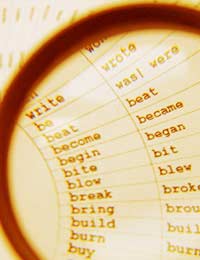Using English Verbs, Adverbs and Adjectives

Verbs, adverbs and adjectives are all important parts of English Grammar. Read on to see examples and definitions.
Verbs
Verbs are the building blocks of English grammar. The shortest sentences, including one word sentences, include a verb.Verbs are usually described as being “action words”. While verbs do give the impression of actually “doing” something, they can also convey an idea of state, of existence and of “being”.
Verbs that are “doing” words are as follows:
- Run
- Do
- Fight
- Work
Verbs that imply state:
- Seem
- Exist
- Be
- Belong
A verb can always be found with a subject. In the following sentence “Richard speaks Spanish”, Richard is the subject, so the word speaks is the verb.
So, to simplify matters, the verb is the word that tells us what any subject is or is doing. Verbs can describe both action and state:
- Action - Isabelle plays tennis. – The verb here is plays.
- State – Isabelle seems quiet. – The verb here is seems.
Verbs are a special part of the English language, as they can change their form. Most of the other types of words in the English language such as prepositions, adjectives and so on cannot.
Let’s look at the verb “to work”. It actually has five forms:
- To work
- Work
- Works
- Worked
- Working
Adverbs
Adverbs are the words that tell us more about the actual verb that is being used. It is the adverb that changes the verb, and they can also change adjectives.We are taught to recognise adverbs by the three following characteristics:
- Function
- Form
- Position
The Adverbs Function
The main job of the adverb is to give us more detailed information about the adjective, verb and other adverbs being used.Changing A Verb
- Daniel speaks quietly – The adverb in this sentence is quietly, and the word it is changing is speaks.
- Sarah lives locally – the adverb is locally and the word being changed is lives.
The adverbs have many other functions such as changing an entire sentence or changing certain phrases.
The Adverbs Form
You may notice that many of the adverbs end in –ly. Adverbs are actually formed by adding –ly to the end of an adjective:- Softly
- Quickly
- Honestly
- Strongly
Don’t think though, that all words that end in –ly must be adverbs. Some words such as “friendly” are actually adjectives.
The Adverbs Position
The adverb can be found in three places in a sentence: the beginning, the middle and the end. When the adverb is at the beginning, it will come before the subject. When it is in the middle, it will come between the subject and then the main verb. When at the end of a sentence, the adverb will be after either the verb or the subject.Adjectives
The adjective is the word that will give us more information about the noun. Noun also includes noun phrases and pronouns. Just like the adverbs, the adjectives change the noun.The adjective can be used before a specific noun:
- I like Chinese food – “Chinese” being the adjective and “food” being the noun.
Or, the adjective can be used after some verbs:
- It is hard – “Hard” being the adjective and “it is” being the verb.
This is just a basic look at the ways verbs, adverbs and adjectives fit into English grammar. There are many printed books that go into every aspect of English grammar and how to use it. This overview will give you a good starting point when you start to learn English grammar.
- Different Uses for the Comma in English Grammar
- A Look at English Prepositions
- English Language: What is Parenthesis?
- A Basic English Grammar Glossary
- A Look at English Nouns and Pronouns
- Using English Idioms
- How to Write Paragraphs
- Confusing Different Words in English Language
- Why You Need to Know Common Grammar Terminology
- Children and English Grammar
- Why English Grammar Is Important


Re: Why English Grammar Is Important
There are a certain parts that werent.... Or There are certain parts that werent...
Re: Understanding Intonation and Stress in Speech
How much for the intonation e-book? Best regards, Lily
Re: English Language: Silent Letters
@Deb - according to the Cambridge Dictionary, it should be pronounced 'wenz.de', which doesn't sound right - I think…
Re: English Language: Silent Letters
I have never known the "d" in Wednesday to not be pronounced - it should be Wed-nes-day - which is from the Germanic Wodan's…
Re: Using English Verbs, Adverbs and Adjectives
i need to know all the adjectives and verbs for my GCSE exam omg i am sick of exams now they are anoying me
Re: Using English Idioms
I found the contents very useful and relevant to my classroom transations.
Re: What You Will Need to Learn English
i love reading your article it help me to understand how important for me to reading english.. i want to learn english…
Re: How to Write Paragraphs
As a teacher teaching English I find your website helpful. Cheers
Re: Ten Tips to Help You Learn English as a Second Language
The biggest mistake Spanish students make is trying to translate word for word. For example;…
Re: English Language: Silent Letters
A longtime since ive been in grammer school.I will be 80 years old my next birthday, This is a very enlightening ,and helpful…